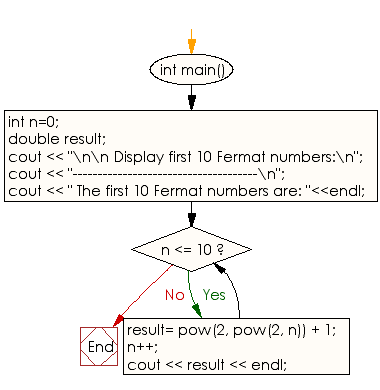C++ Exercises: Display first 10 Fermat numbers
C++ Numbers: Exercise-33 with Solution
Write a program in C++ to display first 10 Fermat numbers.
Sample Solution:
C++ Code :
# include <iostream>
# include <math.h>
using namespace std;
int main()
{
int n=0;
double result;
cout << "\n\n Display first 10 Fermat numbers:\n";
cout << "-------------------------------------\n";
cout << " The first 10 Fermat numbers are: "<<endl;
while (n <= 10)
{
result= pow(2, pow(2, n)) + 1;
n++;
cout << result << endl;
}
}
Sample Output:
Display first 10 Fermat numbers: ------------------------------------- The first 10 Fermat numbers are: 3 5 17 257 65537 4.29497e+09 1.84467e+19 3.40282e+38 1.15792e+77 1.34078e+154 inf
Flowchart:

C++ Code Editor:
Contribute your code and comments through Disqus.
Previous: Write a program in C++ to check whether a given number is a perfect cube or not.
Next: Write a program in C++ to find any number between 1 and n that can be expressed as the sum of two cubes in two (or more) different ways.
What is the difficulty level of this exercise?
